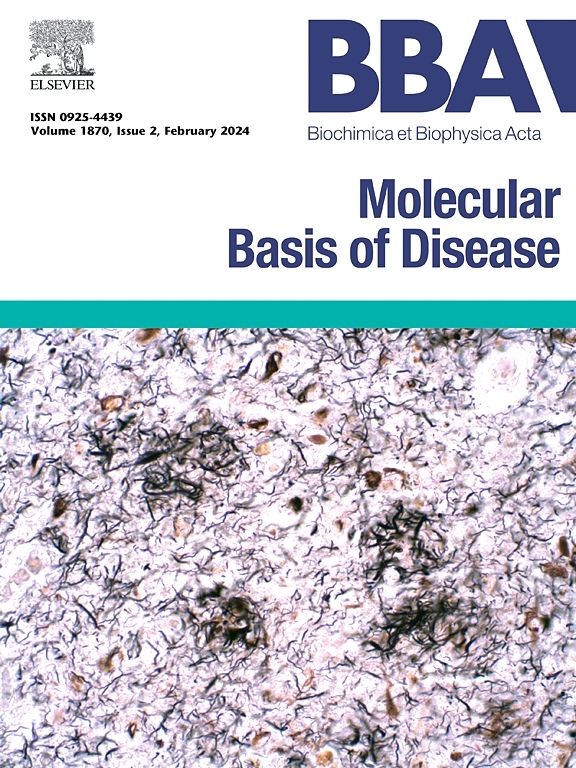一种新的Asp20Tyr取代引起的遗传性AApoAI淀粉样变性的不寻常表型与载脂蛋白a - i的ph依赖性聚集有关
IF 4.2
2区 生物学
Q2 BIOCHEMISTRY & MOLECULAR BIOLOGY
Biochimica et biophysica acta. Molecular basis of disease
Pub Date : 2025-03-29
DOI:10.1016/j.bbadis.2025.167820
引用次数: 0
摘要
载脂蛋白A-I (apoA-I)是血浆高密度脂蛋白(HDL)的主要结构和功能蛋白。然而,APOA1基因突变可在人类遗传性AApoAI淀粉样变性中引起蛋白质错误折叠和各种器官的病理性淀粉样沉积,这是一种潜在的致命性全身性疾病。我们报告一例56岁Barrett食管患者的食管和十二指肠AApoAI淀粉样变,该疾病涉及慢性胃酸反流。淀粉样蛋白沉积物含有全长apoa - 1,通过基因测序和蛋白质质谱分析鉴定出了一种新的D20Y突变。无症状家庭成员的遗传分析显示常染色体显性遗传。在遗传性AApoA-I淀粉样变性中,全长变异apoA-I而不是其片段形成纤维,并且突变位置在保守的淀粉样蛋白易感性n端段,这是非常不寻常的。重组D20Y和野生型apoA-I的结构和稳定性研究表明,在pH 7.4时,天然无脂蛋白的结构发生了微小但显著的突变。在pH 4.0时观察到变异蛋白的主要不稳定和聚集。我们认为Barrett食管的酸性条件促进了D20Y变异蛋白的错误折叠和淀粉样蛋白的形成。这些发现扩大了我们对AApoAI淀粉样变的临床特征和分子基础的理解,并提出了临床策略。本文章由计算机程序翻译,如有差异,请以英文原文为准。

An unusual phenotype of hereditary AApoAI amyloidosis caused by a novel Asp20Tyr substitution is linked to pH-dependent aggregation of apolipoprotein A-I
Apolipoprotein A-I (apoA-I) plays beneficial roles as the major structural and functional protein on plasma high-density lipoproteins (HDL). However, APOA1 gene mutations can cause protein misfolding and pathologic amyloid deposition in various organs in human hereditary AApoAI amyloidosis, a potentially lethal systemic disease. We report esophageal and duodenal AApoAI amyloidosis in a 56-year-old patient with Barrett's esophagus, a condition involving chronic acid reflux. Amyloid deposits contained full-length apoA-I featuring a novel D20Y mutation identified by gene sequencing and protein mass spectrometry. Genetic analysis of asymptomatic family members revealed autosomal dominant inheritance. Fibril formation by the full-length variant apoA-I rather than its fragments and the location of the mutation in a conserved amyloid-prone N-terminal segment were highly unusual for hereditary AApoA-I amyloidosis. Structural and stability studies of the recombinant D20Y and wild-type apoA-I showed small but significant mutation-induced structural perturbations in the native lipid-free protein at pH 7.4. Major destabilization and aggregation of the variant protein were observed at pH 4.0. We propose that acidic conditions in Barrett's esophagus promoted protein misfolding and amyloid formation by the D20Y variant. These findings expand our understanding of the clinical features and molecular basis of AApoAI amyloidosis and suggest clinical strategies.
求助全文
通过发布文献求助,成功后即可免费获取论文全文。
去求助
来源期刊
CiteScore
12.30
自引率
0.00%
发文量
218
审稿时长
32 days
期刊介绍:
BBA Molecular Basis of Disease addresses the biochemistry and molecular genetics of disease processes and models of human disease. This journal covers aspects of aging, cancer, metabolic-, neurological-, and immunological-based disease. Manuscripts focused on using animal models to elucidate biochemical and mechanistic insight in each of these conditions, are particularly encouraged. Manuscripts should emphasize the underlying mechanisms of disease pathways and provide novel contributions to the understanding and/or treatment of these disorders. Highly descriptive and method development submissions may be declined without full review. The submission of uninvited reviews to BBA - Molecular Basis of Disease is strongly discouraged, and any such uninvited review should be accompanied by a coverletter outlining the compelling reasons why the review should be considered.

 求助内容:
求助内容: 应助结果提醒方式:
应助结果提醒方式:


